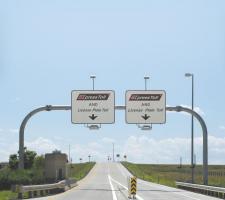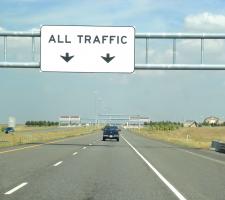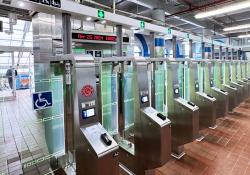
Camera installation: the ability of the SpikeHD from PIPS Technologies to take both front and rear plate shots was central to the violation enforcement systems upgrade
Teri England,
E-470 toll road
E-470 is a toll road situated to the east of Denver, Colorado and prior to 4 July 2009 it had a mix of automatic cash machines, manual and express (high-speed) toll lanes. The toll road opened in 1991 and since then road users have had the option of paying their tolls by cash or EXpressToll (the transponder-based toll collection system used by E-470, the Northwest Parkway and the I-25 tolled express lanes in Colorado). These customers have their tolls deducted automatically from a pre-paid toll account. Since E-470's inception, all of the main highway lanes have passed through the middle of all mainline plazas. Thus, non-stop (highway-speed) multi-lane tolling has been an established feature for some time.LPT is an alternative method of payment for users who do not have an EXpressToll transponder. Cameras photograph the vehicles' front and rear license plates and for all tolls incurred in a month a single bill is issued to the registered owner of the vehicle. For all EXpressToll customers, payment options have not changed; they continue to pay via their pre-paid accounts (by comparison with LPT customers, EXpressToll customers pay a lower toll rate on E-470).
First phase
The first phase commenced when E-470 switched over the high-speed express tolling lanes to AETC six months prior to closing the conventional cash lanes and thus going completely cashless. This period allowed for both E-470 and the travelling public to get used, in a gradual fashion, to this new way of working. On 1 January 2009, therefore, what would have previously been violators in the express lanes became new LPT customers for E-470.Prior to this first phase taking place, and for LPT to be successful, the Violation Enforcement System (VES) had to be evaluated as a revenue collection system, rather than just a violation system. The results of the evaluation determined that an upgrade of the technology would be required to improve revenue assurance. Several systems were evaluated and the
The E-470 VES originally only took rear license plate shots. The upgrade to the new VES involved taking front and rear image captures, thus increasing the ability to automatically identify a vehicle. This works for both cars and trucks because Colorado mandates front and rear plates for all vehicles, which better enables identification of the vehicle owner.
The major integration work for this project involved introducing the PIPS cameras into the E-470 lanes and testing the software and back-up strategy. In normal operation, the cameras are triggered by the lane controller using information supplied by the
The new camera installation work for 106 toll collection locations began on 10 November 2008 and was completed on all toll lanes by May 2009. The installation of the cameras was completed through the coordination of the E-470 Information Technology team, including the Idris team, Operations, roadway staff, and utilising two contractors for any infrastructure work.
Danna Smith, E-470's Accountant: "Through the use of LPT bills, E-470 could have experienced a loss of revenue from image rejections, customers not paying their bills, not being able to capture license plates in order to bill the registered owners, and a quantity of returned bills due to bad addresses. After considering these impacts, we realised we needed to work on our camera system and that prompted the implementation of front-shot cameras using the new PIPS camera solution."
This resulted in E-470 using its own software capabilities and working with the PIPS software and Idris development teams to design and deploy new software.
Phase two
Phase two of the AETC project took place on the 4 July 2009 and saw an end to payments by coin and cash; E-470 had become an AETC facility. The timetable put in place to achieve AETC was extremely ambitious, and involved high levels of technical integration between the E-470 and Idris engineering teams.AETC brings with it changes throughout the toll facility, from the road up. When a facility goes cashless, there needs to be serious thought given to the back office operations, acknowledging all the key parts of the system. A major influence is the number of images now generated and which need to be looked at as people without transponders become customers rather than violators. For E-470 this meant various stakeholders had to develop new business rules to meet the needs of how they wanted to implement AETC and their back office. Once the business rules were established, process and system architecture design meetings were held. The outcome was making changes to the current back office rather than re-developing the whole system.
Although the timescale for change from a mixed environment of manual, ACM and high-speed ETC lanes to AETC at first sight appeared to be very optimistic, it was in fact very achievable because the base technologies in place on E-470 did not require major changes. Their main classification and detection system (Idris) already had front-trigger capabilities and the engineering skills of the team ensured that integration of the cameras happened in good time to meet the various operational deadlines.
Communication - a necessity
Communication with the public and toll road users played an important role through the transitional period. Roadway signs were updated and altered accordingly, identifying the changes to lanes as developments took place. An early ongoing PR campaign ensured the public was well informed and regularly updated on progress. Jo Snell, Manager of Community and Public Relations for E-470, and her team had worked since early 2008 on informing the public, communicating the changes which would take place, and the benefits of these actions.Snell: "The public had a very easy time with the transition to a cashless system and the introduction of LPT. They heard it from the media early and often. The media was a good friend to E-470 in covering the story time and time again. The news coverage really helped us get the word out to the public."
All this team effort meant, on the night of the switchover, that E-470 just followed the script it had laid out for itself and the whole activity went according to plan. Director of Operations at E-470, Dave Kristick's comment summed up the feelings of everyone involved with the AETC project: "The cooperation of the departments was the most proving experience in my time here at E-470. It gave us cause to work together in the same direction with the same guidance and motivations to make this project successful."













